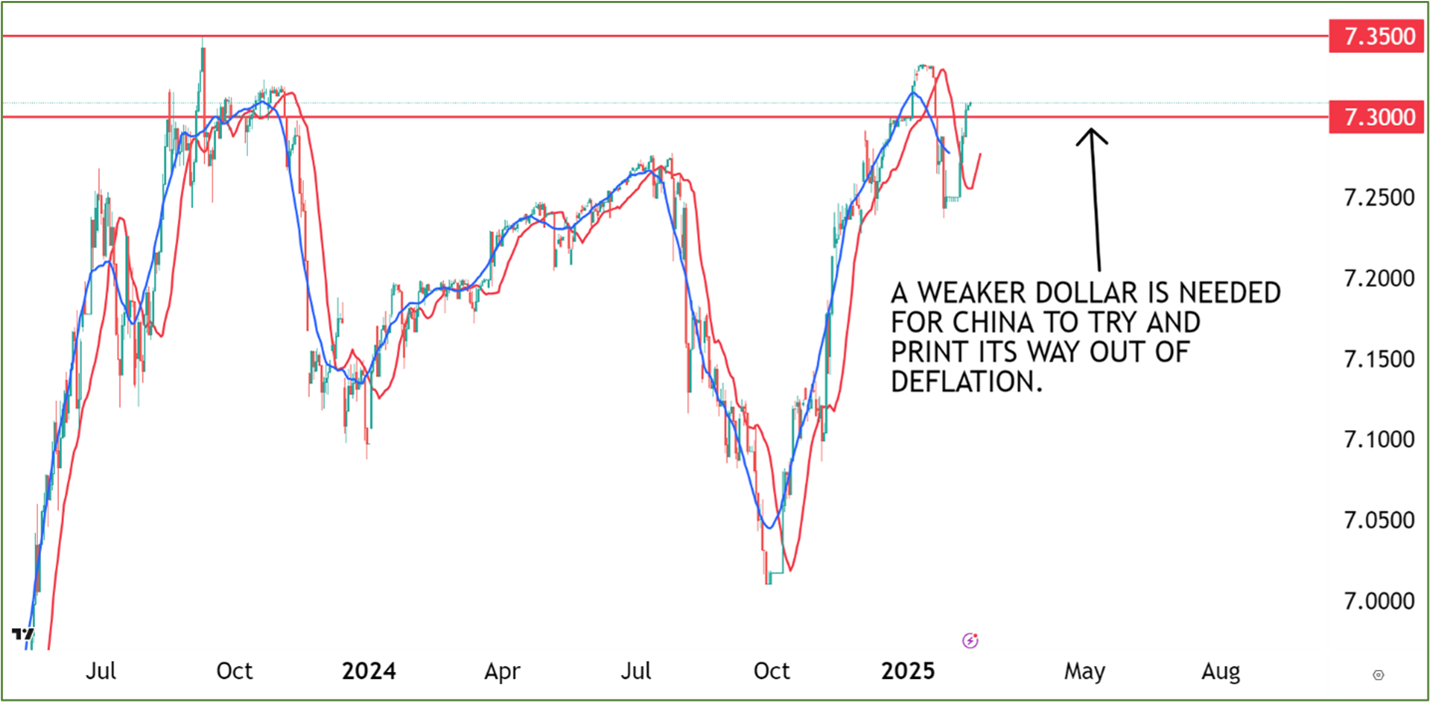 |
| By Juan Villaverde |
As we move deeper into 2025, it’s increasingly clear global liquidity will remain constrained for the foreseeable future. And largely because of the Federal Reserve’s elevated interest rates.
The current target range for the Fed funds rate is 4.25% to 4.50%.

Plus, the Fed is unlikely to reduce it anytime soon. That’s because of persistent inflationary pressures, which are further exacerbated by White House tariff policies.
Accordingly, the latest Fed projections point to:
- Economic growth of about 1.7% in 2025, which is down from earlier estimates of 2.1%. And …
- Core Personal Consumption Expenditure (PCE) inflation rising to 2.8%.
These numbers underscore the Fed’s focus on containing inflation, a stance reinforced by the current administration’s proactive fiscal policies.
Overseas, China faces a different but equally restrictive environment. Deflationary pressures are coming from a struggling real estate sector — where home prices have dropped roughly 30% since their 2021 peak.
And this is forcing the People’s Bank of China (PBoC) to attempt to bail out its banking sector.
To date, the PBoC has maintained its Loan Prime Rate at 3.1%. But any aggressive move to inject liquidity could undermine the yuan by widening the yield gap with the U.S.
Already this has become an issue. The U.S. dollar/Chinese yuan exchange rate has been above Beijing’s psychologically sensitive 7 CNY per USD level for months — with no signs of easing.

This puts party bosses in a squeeze because of the risk of capital flight. Also, a further currency slide limits Beijing’s ability to stimulate the economy. Especially in the face of rising tariffs and faltering global economic growth.
Europe is also feeling the squeeze, as geopolitical factors push defense spending higher. In Germany, increased funding for defense and infrastructure has already boosted 10-year Bund yields to nearly 3%, creating a ripple effect of rising borrowing costs across the Eurozone.
Finally, the European Commission’s proposal to borrow up to €150 billion comes just as elevated U.S. interest rates make international borrowing more expensive.
Simply put, the European Union can’t borrow all the euros it needs without causing significant damage to Euro bond markets. And the European Central Bank is unable to step in with a rescue, because of elevated U.S. dollar interest rates.
Tepid Liquidity Growth Leads to Tepid Crypto Rallies
To be clear, my Crypto Timing Model still expects a relief rally in the second quarter.
But my model only tracks when a cycle starts, reaches its peak and ends. It does not measure how high a rally can go.
That’s why I don’t love making wild price projections, no matter how fun it may be to imagine Bitcoin (BTC, “A-”) ripping higher. Usually, my estimates are conservative, based on how high previous rallies within a cycle went … and what’s happening with global liquidity levels.
Because in every crypto bull market, ample liquidity has been a critical driver of higher prices, as investors seek higher returns in risk-on assets.
But for now, the Fed is keeping interest rates “higher for longer.” Moreover, other central banks are similarly constrained.
So, even as world liquidity rises — and it has been for months — its rate of growth is quite subdued.
Bitcoin’s current rally began March 11, under $80,000. As I write, it’s barely up 10% — which, for crypto, is very small indeed. You could say Bitcoin’s price rise has been as subdued as global liquidity itself.
What likely lies ahead for the next few weeks is more of the same: More sideways chop, with only a small net gain in price.
But all that is set to change in the second half of this quarter.
Which means you should get your plan for how to ride this rally together now.
Best,
Juan Villaverde

